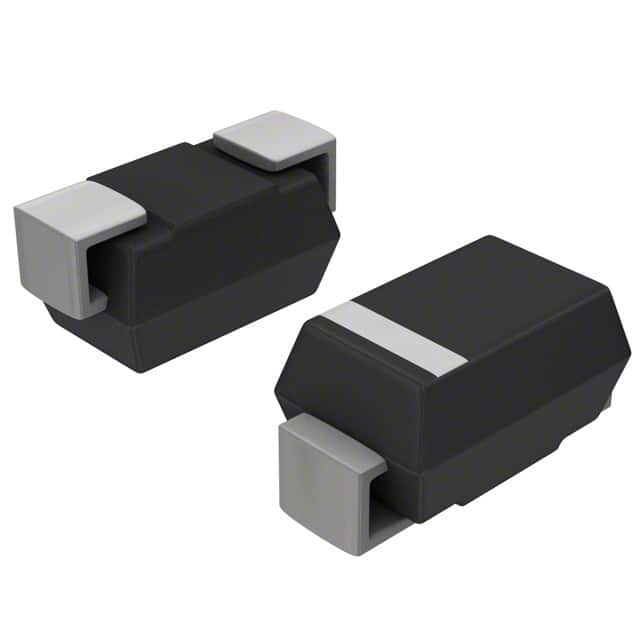S1M-LTP Product Overview
Introduction
The S1M-LTP is a crucial component belonging to the category of semiconductor devices. This device is widely used in various electronic applications due to its unique characteristics and functional features. In this entry, we will delve into the basic information overview, specifications, pin configuration, functional features, advantages and disadvantages, working principles, application field plans, and alternative models of the S1M-LTP.
Basic Information Overview
- Category: Semiconductor Devices
- Use: Rectification and voltage regulation in electronic circuits
- Characteristics: High efficiency, low forward voltage drop, fast switching speed
- Package: S1M-LTP is typically available in a DO-214AC (SMA) package
- Essence: It serves as a rectifier diode for converting alternating current (AC) to direct current (DC)
- Packaging/Quantity: Commonly packaged in reels with varying quantities based on manufacturer specifications
Specifications
The S1M-LTP diode has the following specifications: - Maximum Repetitive Peak Reverse Voltage: 1000V - Average Forward Current: 1A - Peak Forward Surge Current: 30A - Operating and Storage Temperature Range: -65°C to +175°C
Detailed Pin Configuration
The S1M-LTP diode has a standard pin configuration with two leads, anode, and cathode, which are essential for proper circuit integration and functionality.
Functional Features
- Fast recovery time
- Low leakage current
- High surge capability
- Reliable reverse avalanche characteristics
Advantages and Disadvantages
Advantages
- Efficient rectification of AC to DC
- Fast switching speed
- Low forward voltage drop
- High surge capability
Disadvantages
- Susceptible to thermal runaway under certain conditions
- Limited reverse voltage tolerance compared to other diodes
Working Principles
The S1M-LTP operates based on the principle of rectification, where it allows current flow in one direction while blocking it in the opposite direction. When subjected to an AC input, the diode conducts during the positive half-cycle, allowing current to flow, and blocks during the negative half-cycle, preventing current flow.
Detailed Application Field Plans
The S1M-LTP diode finds extensive use in various applications, including: - Power supply units - Voltage regulators - Inverters - Battery chargers - Lighting systems - Industrial equipment
Detailed and Complete Alternative Models
Several alternative models to the S1M-LTP diode include: - 1N4007: A general-purpose diode with similar voltage and current ratings - UF4007: Ultrafast diode with improved switching characteristics - FR107: Fast recovery diode suitable for high-frequency applications
In conclusion, the S1M-LTP diode plays a vital role in electronic circuits, providing efficient rectification and voltage regulation. Its unique characteristics, functional features, and diverse applications make it an indispensable component in modern electronics.
Word Count: 410
Lista 10 Vanliga frågor och svar relaterade till tillämpningen av S1M-LTP i tekniska lösningar
What is S1M-LTP?
- S1M-LTP stands for Secure 1-Minute Long-Term Potentiation, a security protocol used in technical solutions to establish secure and long-lasting connections.
How does S1M-LTP enhance security in technical solutions?
- S1M-LTP enhances security by using advanced encryption and authentication methods to protect data and communication channels from unauthorized access and tampering.
Can S1M-LTP be integrated with existing technical solutions?
- Yes, S1M-LTP can be integrated with existing technical solutions through APIs and software development kits, allowing for seamless implementation of its security features.
What are the key benefits of using S1M-LTP in technical solutions?
- The key benefits of using S1M-LTP include enhanced data security, establishment of long-term secure connections, and protection against various cyber threats such as eavesdropping and data manipulation.
Is S1M-LTP suitable for IoT devices and applications?
- Yes, S1M-LTP is suitable for IoT devices and applications, providing robust security measures for the communication and data exchange between connected devices.
Does S1M-LTP support multi-platform compatibility?
- Yes, S1M-LTP supports multi-platform compatibility, allowing it to be implemented across various operating systems and hardware configurations.
How does S1M-LTP handle key management and distribution?
- S1M-LTP employs advanced key management techniques to securely generate, distribute, and manage cryptographic keys, ensuring the integrity and confidentiality of communication channels.
Can S1M-LTP adapt to dynamic network environments?
- Yes, S1M-LTP is designed to adapt to dynamic network environments, maintaining secure connections even in scenarios involving network disruptions or changes.
Are there any performance considerations when implementing S1M-LTP in technical solutions?
- While S1M-LTP introduces additional computational overhead due to its security measures, its performance impact is generally minimal and well-optimized for efficient operation.
Is S1M-LTP compliant with industry standards and regulations?
- Yes, S1M-LTP is designed to comply with industry standards and regulations related to data security and privacy, making it suitable for use in various sectors and applications.


